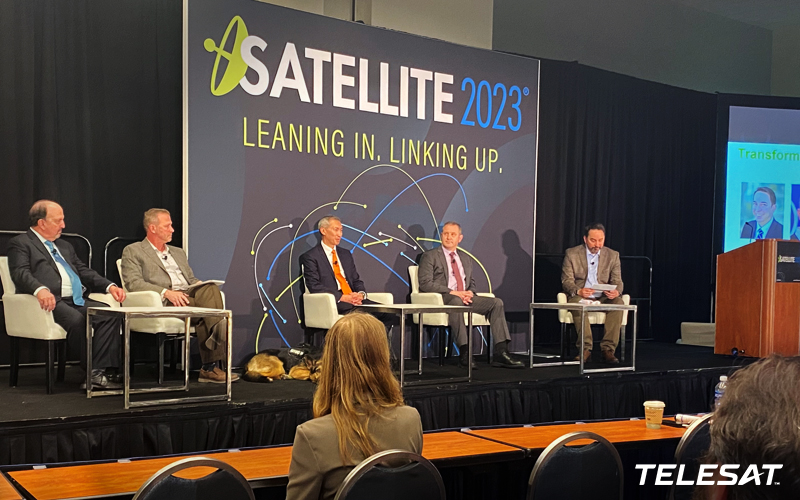Satellite 2023 Panel Discussed Accelerating New Capabilities
The panel discussion Transforming Battlespace Communications was held last week during the Satellite 2023 conference in Washington, D.C. Two government officials and two industry veterans shared their views on how new processes and technologies are changing the space-based capabilities available for national defence. The panelists were:
Dr. Frank Turner, Technical Director, Space Development Agency (SDA)
Mike Dean, SATCOM Chief, DoD CIO
David Robinson, Director of Government Programs, Iridium
Rich Pang, Vice President, Corporate Development, Telesat Government Solutions
The discussion was moderated by Craig Miller of Viasat, and a general theme quickly emerged as the panelists responded to his questions. The pace of change around battlespace communications has increased. Yet more needs to be done to accelerate the introduction of innovative commercial services and fold these new services into the Concept of Operations (CONOPS) for space missions.
Dr. Turner talked about how the SDA is using different authorizations to operate (ATOs), to move faster in their procurement process. On the other hand, he also stressed the importance of a flat approval process and pushing approval authority down the chain to increase speed and agility. He referred to this as “getting out of your people’s way.”
In one of his responses, Mike Dean introduced himself as the “managed services provider” for the DoD. He acknowledged that the DoD is working to publish clearer standards and requirements, and counseled companies offering satellite services to the DoD to make sure their ground systems are already in place.
David Robinson made some interesting observations on how the line between active duty and the home front has become blurry. He attributed this to increased gray zone competition being focused on the United States by near-peer adversaries. Such competition encompasses things like election meddling, cyber-attacks and economic coercion. In addition to formal battlespace environments, this kind of conflict requires the government to tap into commercial innovation.
Telesat Government Solutions’ Rich Pang talked about the importance of commercial being an integral part of the military architecture in space. He said, “we have to make LEO systems as open, interoperable and flexible as possible for defense systems while ensuring we meet stringent TRANSEC and IA-Pre standards.” Rich also talked about how procurement needs to move faster to keep up with potential adversaries, and how Telesat Lightspeed will meet Metro Ethernet Forum (MEF) standards for easy integration into terrestrial networks.
Rich also responded to a comment from Dr. Turner about how to balance the need for standards vs. the need to encourage innovation. Telesat’s LEO satellites will meet Transmission Security (TRANSEC) and Infrastructure Asset Pre-Assessment Program (IA-PRE) requirements from the DoD and will be third-party vetted under the DoD’s Cybersecurity Maturity Model Certification. Standards allow disparate systems to be interoperable and provide a set of parameters from which we can level-set expectations and provide a foundation for innovation.
It’s encouraging that government decision-makers are realizing that they can look to commercial providers for fully managed networks and services, not simply capacity. The commercial industry has developed capabilities and services that can be quickly leveraged for government use, preserving information dominance in the battlespace and beyond.
Telesat Government Solutions is working on multiple contracts and projects to provide the most advanced space technology available to government customers. Telesat is proving the efficacy of optical inter-satellite links (OISLs) as part of the SDA’s Transport Layer Network and DARPA’s Space-Based Adaptive Communications Node (Space-BACN). In addition, the company is demonstrating the ability of RF inter-satellite links (RF-ISLs) to replace NASA’s Tracking and Data Relay Satellite System (TDRSS) on its Communications Services Project (CSP).
Through such contracted programs Telesat Government Solutions continues to showcase the possibilities of Telesat’s LEO network in supporting government space-based connectivity and meeting the U.S. Government’s unique unilateral requirements, including offering secure, true global connectivity throughout the polar regions.
Government and industry working collaboratively have transformed battlespace communications. Based on the Satellite 2023 panel discussion, that relationship will continue to grow in strength and focus.



